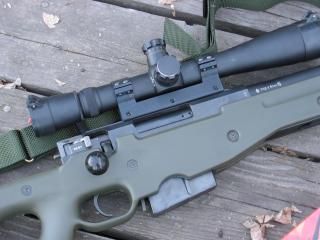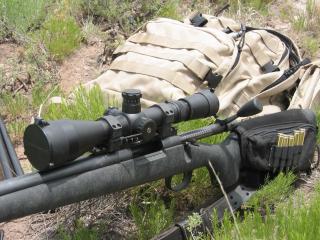So you dialed up 43 MOA for your 980-yard shot, which happens to be almost three full turns of
your elevation knob, which has 45 fourth-MOA clicks per turn for 15 MOA per turn, then forgot to
reset the dial when you left the last shoot position. Now you can't remember exactly which turn
your zero was on. You could easily be one or two full turns off, which is over seven feet error at
500 yards! Now what? This is where the zero-stop comes in. When you dial down a zero-stop knob,
it will physically stop turning right at or a few clicks under your zero. This physically indicates
the zero, and it is much harder to get lost in knob turns. This feature is often paired with a
one-turn knob, where the knob provides all the elevation in a single turn, and doesn't go any
further.
The other thing long-range shooters have to specify is the windage correction, to compensate for
wind drift or target movement. The same considerations apply here as for elevation, except that the
amount of travel is not an issue. The reticle is often used for windage hold-off since dialing wind
is an extra step and the shooter can usually hold off up to a mil or two accurately-enough to make
hits for moderate wind values.

 Without an inclined scope base like this one, the Leupold 3.5-10x40mm M1 is limited to 850-900 yards shooting
standard M118LR 7.62x51 ammunition.
Fixed-power scopes such as the 10x Unertl and the original Leupold Mark 4 used to be the only
serious contenders for military-spec sniper scopes due to durability. However, modern high-end
variable magnification scopes have no problem with durability. At low magnification, they provide
higher speed for close target engagements and more low-light capability. Illuminated reticles are a
necessity for low-light shooting, and they are standard on high-end tactical scopes.
How much magnification do you need? The answer is less than you might think. The scope needs to
provide a clear image of the target for a well-defined sight picture. With good glass, a 12x scope
is more than sufficient for 1000-yard shooting. To test the theory, I dialed down my 3-12x50 mm
Schmidt & Bender scope to 4x and was able to make hits on a 36-inch target at 1300 yards; it was
enough to discern the target from the background. A lot of people think they need very high
magnification to shoot at long range, however, as the magnification is increased, the field of view
gets smaller and it is harder to find the target in the scope. Another problem at high power is
that the size of the exit pupil shrinks, which makes eye position a lot more critical for a full
view through the scope. A smaller exit pupil also makes it harder to track the target though
recoil, which is how a shooter can spot his own bullet impacts. At the low end, dialing down the
magnification makes it easier to find close and track moving targets, and provides a brighter image
in low light. So what's the answer?
For practical shooting to about 1000 yards, a top end of 12x to 16x gets the job done and puts the
low end between 3x and 5x for most scopes. Another reason to pick the lowest magnification that
will work for the longest shots is to help limit rifle weight and bulk.

 The Leupold Mark 4 line is a good value that gets the job done, but lacks some features of the
higher-end scopes. Shown here is a 4.5-14x50mm M1.
Many balk at spending $1000, not to mention almost $3000, on a rifle scope. This is somewhat
misguided. While you consume ammunition, barrels, calories, and vehicle fuel in training and
practice, the scope, rifle action, and stock are essentially fixed costs. The cost of the
consumables will eclipse the fixed costs in just a year or two, while an optic that provides clear
and bright images while being boringly dependable will pay off every time you pull the trigger.
There are four scope brands that are particularly common at long-range training and competitions:
Leupold, Nightforce, US Optics, and Schmidt & Bender. There are cheaper choices, but I recommend
the Leupold Mark 4 line as the baseline choice because it provides the basic features required, is
proven by years of duty use, is unlikely to break, and is backed by an excellent warranty.
Leupold's Mark 4 line of long-range scopes includes four variable-magnification models: 3.5-10x40
mm, 4.5-14x50 mm, 6.5-20x50 mm, and 8.5-25x50 mm. They have between 65 and 75 MOA total elevation
adjustment which is enough to get .308 to 1000 yards if an inclined base is used. All are available
with the M1 knob, which has fourth-MOA clicks in 15-MOA per turn and has no zero stop. The
3.5-10x40 mm models are also available with the M2 and M3 elevation knob, which has one-half or
one-MOA clicks. The single-turn M3 knob also has a zero-stop. Leupold only offers mil-based clicks
in the 4.5-14x50mm "metric", which has six mils per turn of the M1 knob in 0.1 mil clicks. This
scope is the only option for matching click units to reticle units since they have no MOA-based
reticles. First focal-plane (FFP) reticles are only available on the 3.5-10x40 mm and the 8.5-25x50
mm.
|